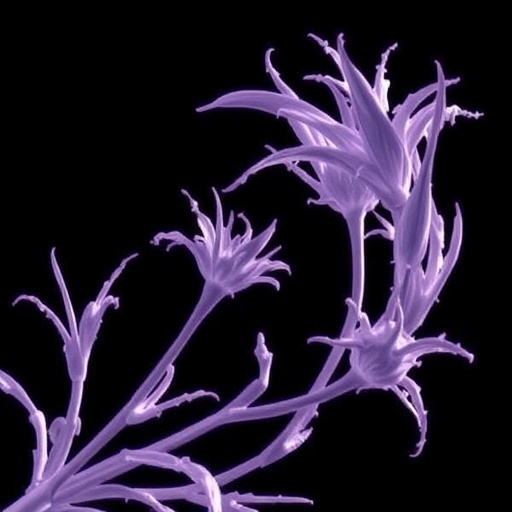In a groundbreaking study, researchers have investigated the intricate morphological variations present in M4 mutants of the IR 841 rice variety (Oryza sativa L.), which were induced by gamma irradiation. This research, set to be published in the esteemed journal Discover Plants, reveals significant insights into how induced mutations can impact rice morphology, offering a window into genetic diversity and adaptation in one of the world’s staple crops. The shift towards utilizing gamma irradiation as a tool for crop improvement underscores the promising advancements in agricultural biotechnology.
The process begins with understanding gamma irradiation, a type of high-energy radiation frequently employed in agricultural research to induce genetic mutations. This method allows scientists to create a diverse population of plants from a single genotype, which can be screened for desirable traits. Leveraging this innovative approach, the researchers have produced M4 mutants of rice that exhibit distinctive morphological characteristics when compared to their progenitors. The implications of these findings could transform how rice breeders approach the enhancement of variety resilience and yield.
The IR 841 variety serves as an ideal model for this study due to its established role in numerous breeding programs worldwide. Rice is integral to food security, especially in Asia, making the investigation into mutations that enhance its growth and adaptability critically important. The M4 generation, being relatively stable, enables researchers to discern clear phenotypic changes and assess their potential agricultural benefits.
Through systematic evaluation, the researchers noted that gamma irradiation produced a wide spectrum of morphological traits, such as variations in plant height, leaf width, and tillering ability. These differences were meticulously documented, showcasing how radiation exposure can drive evolutionary changes even within a single species. This research lays the groundwork for further exploration into how such innovations might contribute to food production amidst changing climate conditions.
Furthermore, the study highlights the potential of utilizing these morphological traits as indicators for selection in breeding programs. Traditional methods rely heavily on phenotypic observation, whereas incorporating modern techniques such as molecular markers alongside these observations can enhance breeding efficiency. The M4 mutants thus represent not just genetic variation but also strategic opportunities for breeders looking to incorporate beneficial traits into new varieties.
As the impacts of climate change continue to challenge agricultural productivity, the urgent need for innovative solutions has never been greater. The use of gamma irradiation to generate genetic diversity could provide new avenues for developing drought-resistant or pest-resistant plant varieties. Insights gained from the IR 841 M4 mutants may allow breeders to tailor varieties that can withstand environmental stressors, thereby ensuring a reliable food supply.
The results from this research contribute to a broader understanding of plant adaptations and the role of mutation breeding in sustainable agriculture. By engaging with this dataset, researchers can better understand the correlation between genetic variation and environmental responsiveness. The significant morphological variations observed illustrate the untapped potential of rice mutants in addressing agricultural challenges.
In conclusion, the research conducted on the morphological variations in M4 mutants of IR 841 rice presents a pivotal advancement in the field of plant sciences. As researchers continue to delve into genetic diversity induced by gamma irradiation, the agricultural community may find innovative solutions to pressing food security issues. The transition towards utilizing such advanced biotechnological methods promises to enrich the genetic pool of essential crops, ensuring that we are better equipped to face the challenges of tomorrow.
The implications of this work extend beyond the immediate findings. The awareness of how gamma irradiation induces changes at the morphological level encourages a paradigm shift in both research and practical applications in agriculture. As these methods gain credibility, more scientists will likely adopt mutation breeding as a cornerstone for future agricultural innovations.
Through collaborations and a concerted effort from various stakeholders in the agricultural sector, this research can spark initiatives aimed at mitigating food shortages globally. Rice, the lifeblood of billions, stands to benefit enormously from these developments, thereby reinforcing the significance of genetic research in combatting food insecurity.
Ultimately, as these genetic opportunities unfold, the narrative of rice cultivation will evolve, continuing to adapt to the dynamic needs of a growing global population. The journey of discovery is far from over, making the forthcoming publication an essential read for researchers, agronomists, and policymakers alike who are shaping the future of sustainable agriculture.
Subject of Research: Morphological variations in M4 mutants of IR 841 Rice (Oryza sativa L.) induced by Gamma irradiation.
Article Title: Assessment of morphological variations in M4 mutants of IR 841 Rice (Oryza sativa L.) induced by Gamma irradiation.
Article References:
Tchokozi, M., Ayisah, D.K., Mawussi, G. et al. Assessment of morphological variations in M4 mutants of IR 841 Rice (Oryza sativa L.) induced by Gamma irradiation.
Discov. Plants 2, 232 (2025). https://doi.org/10.1007/s44372-025-00299-w
Image Credits: AI Generated
DOI:
Keywords: Gamma irradiation, rice mutants, morphological variations, Oryza sativa, genetic diversity, crop improvement, sustainable agriculture.




